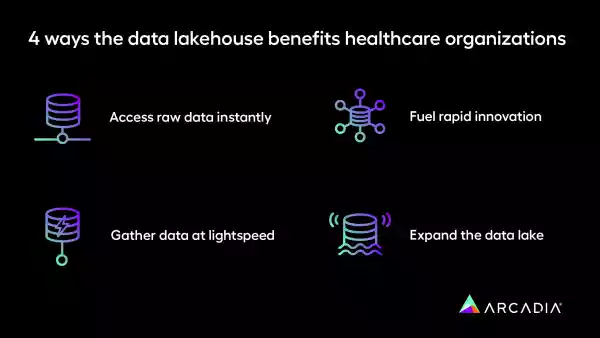What a data lakehouse unlocks for healthcare organizations
Learn how the data lakehouse is revolutionizing healthcare data management, from faster insights to smoother workflows.
A robust healthcare data management architecture isn't a luxury — it's a necessity. For decision-makers at large health systems, ACOs, and CINs, the challenge is to find an interoperable platform that can quickly leverage data. This article explores how integrating advanced technologies, such as a data lakehouse, artificial intelligence, and real-time analytics within a single platform can enhance operational efficiency and patient outcomes. We will examine the critical role of a comprehensive data platform architecture in driving transformative growth for healthcare organizations, emphasizing the importance of seamless integration and swift data utilization.
What is the data lakehouse?
Combining the strengths of a data lake and a data warehouse, the lakehouse model offers an unparalleled platform. Here, highly structured, user-friendly schema can integrate seamlessly with unstructured or pseudo-structured data.
The speed and flexibility of a data lakehouse architecture enables real-time production dashboards and reports. For health data management platform users, this means getting the information they need without an overwhelming amount of data they don’t. It also means that information is ready fast, and users can trust its reliability and quality.
3 capabilities that enhance the data lakehouse
The lakehouse architecture is a critical part of healthcare's data transformation, and several complementary components support it. Here are three key aspects that enhance the capabilities of the data lakehouse:

- Improved data authoring: As users add or adjust data, it’s instantly available for developing new apps and workflows. This means important information isn’t lost in different versions or updates, and every user works with the timeliest, most precise data.
- Innovative connectors: Major data platforms like Arcadia are discovering how to incorporate novel data into the lake without elaborate connector builds.
- Precise data and job monitoring: New methods to gauge data completeness, recency, and job statuses enhance data and job monitoring. As data processes run, users don’t need to constantly monitor whether hurdles have come up, which means they can focus their attention on other pressing projects.
Moving from enhancements to direct benefits, the next section highlights how the data lakehouse supports healthcare workflows and innovation. It will cover instant data access, adaptive integration, and the impact on efficiency and innovation within healthcare organizations. This demonstrates the data lakehouse’s role in advancing healthcare technology.
4 ways the data lakehouse benefits healthcare organizations
The data lakehouse matters in healthcare because it provides the baseline technology to support current workflows, but it’s also primed for whatever the future holds. Tomorrow’s innovations — especially AI and machine learning — depend on speedy, reliable data. The data lakehouse offers the following features that are essential for this future-proofing:

- Access raw data instantly: Files pass through the modern connectors almost immediately, in an unaltered form, so the data an org receives is both timely and raw. This enhances data liquidity and unlocks use cases in record time.
- Gather data at lightspeed: The lakehouse’s innovative design ensures data is available immediately, as soon as it's produced. Data-oriented users: say goodbye to the days of waiting for extensive batch SQL normalization jobs.
- Fuel rapid innovation: Universal access to the data lake lets users across multiple domains speed up their processes and work efficiently, eliminating slow software release and upgrade cycles.
- Expand the data lake: The lakehouse’s adaptive “schema-less” connector lets administrators incorporate novel third-party data into reporting layers. This rapid, fluid process allows quick, easy structuring of this data for future use cases. As an organization’s goals and processes change, the lakehouse adapts in tandem.
Next, we’ll explore how this foundational architecture not only supports current operational needs but also paves the way for embracing future technological advancements and meeting evolving healthcare demands.
How the data lakehouse unlocks healthcare performance
The data lakehouse and its complementary capabilities help healthcare organizations improve performance in the following ways:

- Swifter workflow migrations: Enables timely data and smoother workflows.
- Prompt telemetry and data health monitoring: Lessens unexpected problems for healthcare organizations.
- Easy-to-locate data: Mitigates users having to scour a system wondering, “Where’s my data?” One unified data source provides an easy answer. This also helps systems develop customer-focused support tools more rapidly, and monitor them effectively.
- New data types: Offers both the technology and the strategy to promptly onboard new data types, accelerating partnerships.
- Custom analytics: Helps healthcare organizations address the diverse data needs of customers more simply, eliminating the necessity for custom-coded solutions.
The data lakehouse’s greatest asset is its adaptability. Even the most forward-thinking innovators can’t predict the future, but as new needs emerge , the lakehouse allows organizations to adapt. With custom analytics, the lakehouse supports each user’s individual goals but doesn’t require departments to spend time building custom-coded solutions.
Finally, we examine the future of healthcare data architecture. A strong data platform based on the data lakehouse architecture is essential for addressing future healthcare needs.
The future of healthcare data architecture
In healthcare, every moment counts. A data platform provides healthcare organizations with a strong foundation so they can keep up with changes and apply new technology as it develops, and as new needs arise.
Accessing, analyzing, and acting on data can be the difference between staying afloat and soaring over hurdles. The right platform and architecture not only facilitate this but also empower organizations to build tailored solutions, serve stakeholders efficiently, and position themselves at the forefront of healthcare innovation.
For leaders aiming to future-proof their organizations, understanding and leveraging a data platform built on a data lakehouse is not just beneficial — it's essential. Learn more about how a platform powered by the lakehouse enables success.
